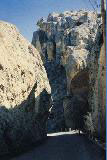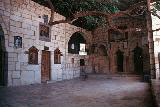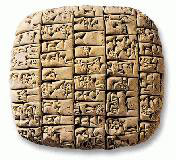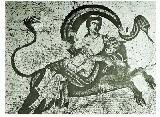Ma'lula
This famous village is some 56 kilometres from Damascus, and is situated at an altitude of more than 1500 metres. Its little houses cling to the face of an enormous rock; they look suspended in mid-air. There are two
monasteries here: Saint Sergius and Saint Taqla's. The inhabitants still speak Aramaic, the language spoken by Christ. Two neighbouring villages, Jaba'din and Naj'a also speak the same language. The word Ma'lula means "entrance" in Aramaic.
Syria Revives Aramaic, Language of Jesus Christ
Arab Aramites
Historical and linguistic studies proved that the Aramites started their journeys from the Arabian Peninsula from which several Arab tribes formed a movement of immigration in the fourth millennium BC, after the rivers of the Peninsula dried up. These tribes migrated to the Mesopotamia in the east, to the Zagross mountains in the north, to the shores of the Atlantic ocean in the west, and to the Arab Sea in the south. The Aramites settled in Syria and in the Mesopotamia (between the Euphrates and the Tigress) and gradually abandoned their style of Bedouin life to adopt the civilized style of settlements. They mostly settled in Amoro (now Syria) and Babylon in the first half of the second millennium BC. With the start of the first Millennium they had established several kingdoms in the region that extended from the anti Lebanon mountains in the west to the Euphrates in the east, and from the mountains of Taurus in the north to Jordan in the south. After several centuries the Aramites gradually, lost control on this region for the Assyrians. The first mention of the Aramites, other than that of the Old Testament, came from the Egyptian letters of Tall al Amarneh of the fourteenth century BC, although there were some weak references about them that date back to the period of 2200 - 1700 BC. The name Aramite was derived from the Arab root of “ram”ò which signifies sublimity and sovereignty.
The Aramaic language
It is the language whose alphabet was derived from the Arabic southern Canaanite language called by the Greeks the Phoenician, i.e. one of the Semitic languages as they were called by Austrian theologian orientalist Schlautser in the second half of the 19th.century, which are really old Arab languages.
Aramaic started to be used in Syria with the beginning of the 18th century BC to breed several languages, linguists divided them into two categories: Eastern Aramaic group which includes the Syriac, the Aramaic of al Raha (now Turkish Orfa), the Babylon language of the Talmud which is an eastern Aramaic used in writing the Talmud in the period between the 4th. and the 6th. century AD, the Mandaaia which is a pure Aramaic used by the Sabians in writing their holy books, and the language of Harran which lent many of its vocabularies to Greek and Latin.
Western Aramaic group
Which includes the Christian Palestinian Aramaic used by Jesus Christ and the Christians of Palestine and Sinai (Syrian Historian Dr. Mohammad Mohaffel says that the Vatican library has a summary of the bible written in this language), the Nabatean which is the language of the Arab Nabateans of Transjordan, and the Palmyran language used by the inhabitants of old Palmyra in central Syria.
These languages were later defined as the eastern Syriac languages. Western Syriac originated when the people of al Raha of northern Syria embraced Christianity and started to write in letters similar to the alphabet of the Strenjilic language of the Kaldanians. Generally all these languages have one common thing, that is they have 22 letters arranged as a,b,c…
Generally speaking, Aramaic is one of the oldest languages in history used for one thousand year in the region. Many historians believe that it constituted the origin of the Greek language and many other European alphabets. When the Persians swept this region they found that Aramaic is the common language that unifies its many ethnicities, so they adopted it as their official language. Persian Sassanides used it to document their history and the Mongols borrowed many of its alphabet. Aramaic was written in three forms: old letters, square letters and the manual letters used as from the middle of the seventh century BC.
Aramaic Institute
For more than 40 years, Professor George Rizqallah was obsessed in Aramaic and always looked for a way to protect it. As an English teacher, a poet by instinct, and a lover of old folk songs he tried to transliterate the local Aramaic songs in Arabic letters, out of his belief that songs and rhythms stick to the memory of people more than normal spoken words which gradually dissolve in oblivion.
To go further he held the first course to teach Aramaic in the monastery of Mar Takla in Ma'aloula, to be followed by three courses; elementary, medium and advanced level, in the monastery and church of St. George. Each course took 45 days. Students of all ages joined these courses in which professor Rizqallah taught the square letters of Aramaic. The idea developed, and an institute to teach Aramaic is now under construction, Mean while courses are being held in a room in the Municipality of Maaloula.
Seydnaya
Some 30 kilometres from Damascus, the village is spread out over a hilltop, and is surrounded by vineyards and olive groves.
It has a famous monastery founded in 547, dedicated to the Blessed Virgin. The name of the village itself, "Seyda Naya" in Syriac means "Our Lady".
The monastery contains a portrait of the Virgin believed to have been painted by St. Luke.
Shrine of Saida Zeinab
Located some 10 kilometres to the south of Damascus.
The interior is covered with decorations in silver and gold, ornate windows and lavish chandeliers. The shrine attracts hundreds of pilgrims daily from various countries, who come to pay tribute to the Prophet's grand-daughter, the daughter of the Imam Ali ibn Abi Taleb.
Zabadani
A summer resort some 45 kilometres north of Damascus, 1175 metres above sea-level. It overlooks the plain of Zabadani, a fertile land with throusands of fruit trees bearing delicious apples, cherries, plums, peaches, and pears. The source of the river Barada is in this plain and it supplies Damascus with water, and irrigates the Ghuta around the city. The source of the river forms a little lake which is surrounded by cafes, restaurants, and play-grounds.
Attracted by its fresh air and beautiful scenery, Damascenes rush to this resort on hot summer days. The area has many hotels and restaurants, cafes and camping sites situated near the banks of the river.
Many Damascenes, however, prefer another nearby resort, Bludan, which spreads over the mountain overlooking Zabadani, at 1500 metres above sea-level, It is cooler here and the scenery is particularly impressive, especially at sunset. Here, too, plenty of hotels, restaurants and cafes cater to the needs of all visitors. Most notable among them is the Grand Hotel, with its spacious terrace that overlooks the entire Zabadani plain.
Also on the hill-top between Zabadani and Bludan, lies the village of Buqein with its famous mineral-spring gushing out of the hillside. It is customary for visitors to stop here and sample this fresh water. This is now bottled and sold in hotels, restaurants and shops throughout the Middle East.
Recreation spots near Damascus are numerous and varied. In the western Ghuta on the banks of the river Barada, you will find hundreds of them concealed under the shade of poplar and willow trees.
The main resting-spots in this valley are: Ein al-Fijeh, Ein al-Khadra, Bassemeh, al-Ashrafieh, al-Hameh, and al-Rabweh. The eastern Ghuta, where the International Airport is located, is also a most attractive part of the Damascus environs. It is full of fruit orchards with apricot, peach, apple, and pear trees.
Also a little to the north of Damascus there are two interesting villages, al-Tel and Mnein (1300 metres above sea level), well-known for their clear springs and pretty cafes.
The village of Erneh is some 52 Kilometres from Damascus, suspended at 1400 metres above sea-level on the slopes of Mount Hermon. It has over 300 springs that converge to create al-A'waj River, and it is well-known for its delicious strawberries, cherries, apples and peaches.











